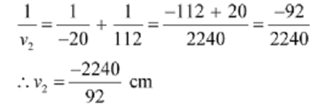Q. (a) Determine the'effective focal length' of the grouping of the two lenses in Exercise 9.10 if they are placed 8.0 cm a part with their principal axes coincident. Performed the answer depend on which side of the combination a beam of parallel light is incident? Is the idea of effective focal length of this system useful at all? (b)T he object 1.5 cm in size is placed on the side of the convex lens in the arrangement (a) above. The distance among the object and the convex lens is 40cm. Determine the exaggeration produced by the two < lens system and the size of the image.
Answer
A Focal length of the convex lens, f1=30cm
A Focal length of the concave lens, f2=-20cm
The Distance between the two lenses d=8.0cm
(a)While the parallel beam of light is incident on the convex lens first:
As-per to the lens formula we have

Where
U1=Object distance=∞
v1=Image distance
v2=Image distance

The image will perform as a real object for the convex lens.
Pertaining lens formula to the convex lens, we have:

Where,
U1=Object distance
=- (20+d)=-(20+8)=-28cm
V1=Image distance

Therefore the parallel incident beam appears to diverge from a point that is (420-4) 416 cm from the left of the centre of the combination of the two lenses.
The answer does depend on the side of the combination at which the parallel beam of light is incident. The notion of effectual focal length does not seem to be useful for this combination.
(b)Height of the image h 1=1.5cm
An Object distance from the side of the convex lens u1=-40cm
|u1|=40cm
As-per to the lens formula:

Where v1=Image distance

Magnification=120/40=3
Therefore the magnification due to the convex lensis3.
The image produced by the convex lens acts as an object for the concave lens .According to the lens formula:

Where
U2=Object distance
=+ (120-8)=112cm.
V2 =Image distance

Magnification 
= 2240/92 x 1/112 = 20/92
Therefore the magnification due to the concave lens is 20/92.
The magnification produced by the grouping of the two lenses is calculated as
m x m'
= 3 x 20/92 = 60/92 = 0.652
The magnification of the grouping is given as

Where
h1= Object size=1.5cm
h2 = Size of the image

Therefore the height of the image is 0.98 cm.